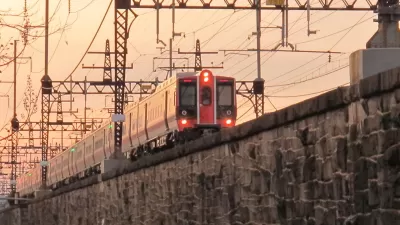As the new federal transportation bill, known as MAP-21, moves to the implementation stage, major finding decisions will ride on the nuances by which the U.S. DOT defines and measures "congestion," "roadway performance," and "cost effectiveness".
"Congress has done its job, such as it is, and passed a transportation bill. Now it's handed off the policymaking to U.S. DOT, which must issue a raft of rules, definitions, and guidance to accompany the new law, known as MAP-21."
Streetsblog asked economist Joe Cortright for his advice to DOT officials struggling to define congestion. His words of wisdom: "Don't make the mistake the Texas Transportation Institute makes."
"TTI's Urban Mobility Report, released every year, invariably gives top honors to places that have overbuilt road capacity. The institute measures congestion only by looking at the degree to which traffic slows down people's commutes. The problem with that, Cortright says, is that 'you end up rewarding places that encourage people to drive longer and longer distances, and then you look at those long distances that they're traveling, and say because they're moving at a relatively higher speed much of the time that they're driving, that the system is somehow performing better.'"
"Cost-effectiveness also can't be measured without examining what are known as 'externalities' -- the costs of driving that are passed on to the public. 'The existing gasoline tax doesn't even cover the maintenance on the highway system that we have now,' Cortright said. 'It doesn't reflect the economic losses to crashes, it doesn't reflect the economic externalities associated with the environmental effects of burning all this gasoline and putting carbon in the atmosphere, and it doesn't reflect the foreign policy and military costs of being so dependent on foreign oil.'"
"If I were U.S. DOT, I'd try to add in, in figuring cost-effectiveness, the cost of all those other subsidies to automobiles," he added.
Thanks to Tanya Snyder
FULL STORY: There’s a Lot Riding on U.S. DOT’s Definition of “Congestion”

Study: Maui’s Plan to Convert Vacation Rentals to Long-Term Housing Could Cause Nearly $1 Billion Economic Loss
The plan would reduce visitor accommodation by 25,% resulting in 1,900 jobs lost.

North Texas Transit Leaders Tout Benefits of TOD for Growing Region
At a summit focused on transit-oriented development, policymakers discussed how North Texas’ expanded light rail system can serve as a tool for economic growth.

Alabama: Trump Terminates Settlements for Black Communities Harmed By Raw Sewage
Trump deemed the landmark civil rights agreement “illegal DEI and environmental justice policy.”

How Community Science Connects People, Parks, and Biodiversity
Community science engages people of all backgrounds in documenting local biodiversity, strengthening connections to nature, and contributing to global efforts like the City Nature Challenge to build a more inclusive and resilient future.

Alabama: Trump Terminates Settlements for Black Communities Harmed By Raw Sewage
Trump deemed the landmark civil rights agreement “illegal DEI and environmental justice policy.”

Dear Tesla Driver: “It’s not You, It’s Him.”
Amidst a booming bumper sticker industry, one writer offers solace to those asking, “Does this car make me look fascist?”
Urban Design for Planners 1: Software Tools
This six-course series explores essential urban design concepts using open source software and equips planners with the tools they need to participate fully in the urban design process.
Planning for Universal Design
Learn the tools for implementing Universal Design in planning regulations.
City of Santa Clarita
Ascent Environmental
Institute for Housing and Urban Development Studies (IHS)
City of Grandview
Harvard GSD Executive Education
Toledo-Lucas County Plan Commissions
Salt Lake City
NYU Wagner Graduate School of Public Service




























